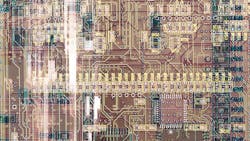Almost all PCBs consist of resin-system components along with some reinforcement. There are two subclasses: glass reinforced and non-glass reinforced. When dimensional stability is essential, designers use woven glass or Gore-Tex. All high-layer-count PCBs must have substantial XY dimensional stability, and require woven glass as part of the laminate. Woven Gore-Tex delivers a slightly lower dielectric constant, but costs more.
Be sure to also check out "Hand-Prototype PCBs Like an Industry Veteran."
Glass-reinforced laminates, many of them proprietary, include low- and high-Tg FR-4 (Tg = glass transition temperature). It’s important to get this right. If low-Tg material is used in a PCB that needs high-Tg material, vias in the finished board will not stand up to soldering. Process control is also critical. Fabrication entails more than 100 process steps.
Fabrication Steps: Computer-Aided Manufacturing (CAM)
CAM is the stage at which customer data files from may arrive in various formats, such as Gerber’s RS-274 X files. These provide data files for each artwork layer, artwork for silkscreens and solder masks, drill data, and a fabrication drawing. They are checked to ensure that all design files are error-free, no files are missing, and specified manufacturing tolerances are achievable. Other design-rule-checking steps include that verification of clearance specifications are met, pad diameters are large enough for reliable soldering, and all layers register with each other.
Panel Sizes
PCBs are manufactured in panels, which come in standard sizes. PCB dimensions may have to be adjusted to maximize use of available panel sizes. The most common dimensions are 18 by 24 inches, which translates to a usable area of 16 by 22 inches.
Lamination Processes
Once all PCB layers have been built, they’re laminated (glued) together. This involves the etched inner-layer laminates, “prepreg” layers, and sheets of foil that form the outer layers. “Prepreg” is a reinforcing fabric that has been pre-impregnated with a resin system, typically epoxy that also includes a curing agent.
The actual lamination step may involve one of several possible methods: heat and pressure only, lamination inside a vacuum bag surrounding the stacked-up layers, or lamination inside a vacuum chamber with the stacked-up layers in a press. Regardless of the technique, the objective is to eliminate the possibility of air bubbles being trapped between layers after the resins have cured.
The next step is to cool down the PCBs after lamination. They can be left to cool in open air. However, if the PCB doesn’t cool down uniformly, it may result in a warped board. It’s better to transfer the laminated, hot PCB to a “cool down” press, maintaining pressure on the PCB while it cools to room-ambient temperature.
PCB fabricators use any one of four lamination methods: foil lamination, mass lamination, sequential lamination, and laminate-only lamination.
“Foil” lamination is usually preferred when there are more than two layers. Adjacent inner layer-pairs are etched back-to-back with pieces of laminate between them. Then they’re stacked on a plate with pins that register the layers to each other. The laminates are separated from each other with prepreg and glue layers. The process finishes by adding a piece of copper foil to each side.
An alternative used by some European fabricators doesn’t use alignment pins on the press plates. All of the inner layers, along with the prepreg separating them, are stacked into a “book,” which is then secured with rivets. Then the top and bottom prepregs and foils are added and the assembly is laminated between the bare press plates. This approach eliminates the need for specially tooled press plates, which makes it possible to process any size panel. The tradeoff is some loss of precision in layer-to-layer registration.
“Mass” lamination becomes an alternative when volumes are high and there’s a maximum of four layers. In this approach, the inner two layers of many PCBs are imaged and etched back-to-back on very large pieces of laminate, often 36 by 48 inches or larger. In this way, many PCBs can be imaged at once. This etched inner layer pair combines with pieces of prepreg and foil on each side, and the whole thing gets laminated. After lamination, “targets” for vias etched on the inner layers facilitate drilling.
If the need arises for buried vias, “sequential” lamination can be used to create “blind” or buried vias. The layer pair with the blind vias is prepared as if it were a two-sided PCB. This piece of laminate combines with the other inner layers, prepreg, and foils, and is subsequently laminated using the standard processes.
About the Author

Don Tuite
Don Tuite (retired) writes about Analog and Power issues for Electronic Design’s magazine and website. He has a BSEE and an M.S in Technical Communication, and has worked for companies in aerospace, broadcasting, test equipment, semiconductors, publishing, and media relations, focusing on developing insights that link technology, business, and communications. Don is also a ham radio operator (NR7X), private pilot, and motorcycle rider, and he’s not half bad on the 5-string banjo.
